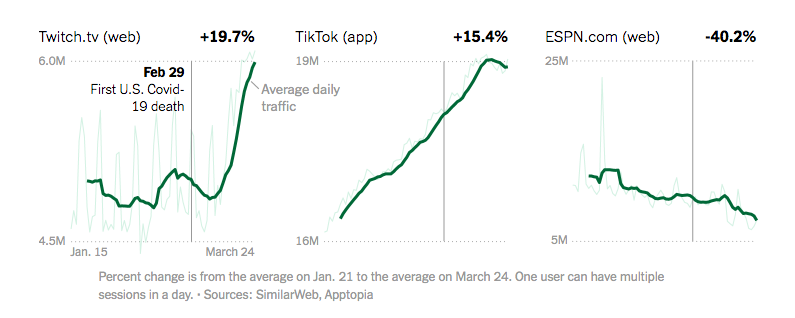With the universal shift to remote online work, a new virtual culture was born. For marketers, this transformation has ushered in a huge shift in the ways consumers engage with brands and consume content. And, content creators have been dealt an entirely new set of limitations in video production.
But, research suggests that constraints actually drive innovation. Given the constraints of our new virtual culture, we compiled 7 ways marketers can drive innovation.
Know Your Audience
Everyone is online. Being able to capture the attention of a wide audience can be impressive, but to really make the most out of our new virtual culture it’s crucial to know your specific target audience. Start with social media – it’s one of the only ways you can directly interact with your consumers during lockdown. This doesn’t mean that you have to rush to every platform. Identify your primary platforms for engaging with your target audience and focus your energy there, first.
Once you’ve identified your target audience, your content strategy can be more personalized to engage that group. Figure out which platforms your audience is drawn to, and then optimize your content to best suit the capabilities of each platform.
Experiment With New Content
In this new virtual culture, chances are a lot of your brand’s pre-planned marketing projects have been put on hold. In place of these postponed projects, take time to explore new online platforms.

Although podcast listening is down, the NYTimes reports that TikTok usage is up by 15.4%. With popular social media platforms like TikTok, there’s a huge opportunity to build new connections in digital spaces. And, TikTok has the highest social media engagement rates per post, when compared to Twitter and Instagram, making it the perfect platform to retain consumer attention. TikTok videos generally have a very basic production value, making it easy to produce content for the platform within our new virtual culture.
In place of podcast listening, consumers have gravitated towards more visual insight through webinars. Dipping into the world of webinars allows your brand to connect with thought leaders in your industry, while also providing valuable on-demand information. Plus, webinars allow for a more open line of communication between your brand leaders and your audience. With question and answer segments, webinars foster a space for live discussion in this new virtual culture.
Creative advertising agencies, including our own Green Buzz team, have taken to webinar programming as a way of leaning into innovative industry education.
Lean Into User-Generated Content
In today’s virtual culture, anybody can be a content creator. And, this extends beyond what we think of as YouTubers. With platforms like Instagram and TikTok adopting livestreaming capabilities and long-form video content, users have the power to create and share like never before. In fact, Instagram Live saw a 70% increase in usage during the month of March in the US alone.
User-generated content (UGC) already had an enormous footprint on the internet, but the pandemic has skyrocketed content creation to new levels. And yet, a lot of marketers haven’t fully accessed its potential for their brands. With consumers in our new virtual culture prioritizing relatability over aspirational content, it’s the perfect time to lean into UGC.
Simplify Your Production Levels
User-generated content isn’t just useful in creating relatable content; it also removes the pressure and cost of creating content with a high-production value. Especially now, video producers are exploring every option for facilitating remote content creation.
But, the new virtual culture created out of the pandemic isn’t the only driver for simplifying production value. Today, consumers are generally more interested in pared down, realistic content.
Plus, with the newest generation of content consumers increasingly skeptical of advertising, marketers need to prioritize authenticity. According to an AdAge study, 84% of Gen Z trusts a company more if they use actual customers in their ads, and 79% will trust a company more if the images its brand uses are not photoshopped. Both of these statistics point to the rising importance of realistic content and user involvement, especially for the future of brand marketing.
Stay Culturally Relevant
With most of people’s social lives now existing on the internet, information travels faster and trends can seem to expire in an instant. But in order to lean into virtual innovation, it’s important to adapt to the speed and tone of online culture.
Marketers should never compromise their unique brand voice to match fleeting trends. However, being aware of consumer perception of industry leaders is an important part of staying relevant. Make sure your team is staying up to speed with what consumers are actually responding positively too. When you’re appropriately engaged, you’ll also have an easier time identifying trends that will stick, and trends that won’t.
Repurpose Existing Content
Even if your team doesn’t have the bandwidth to be creating new content right now, you can transform your existing content for new platforms. By taking existing well-performing video content to new platforms, your brand can expand its reach to new audiences.
Especially when resources are low, repurposing content presents a low investment option for maximizing brand exposure. Try reinventing video content for TikTok, or bringing webinars to IGTV. Expanding into new platforms with old content also serves as a great starting point for your social media strategy. Your well-performing content should already be optimized for your audience, so repurposing that work will only maximize its effectiveness.
Ensure Your Content Can Stand On Its Own
Lastly, make sure that your content isn’t so specific to our current virtual culture that it won’t stand the test of time. Of course, your marketing should always be relevant, but it’s still important for your content to hold up in the future when it exists outside of the cultural context.
To do so, make sure that every message your company sends aligns with its brand values. Your content can be both timely and reflective of your brand’s stated values. Down the line, this ensures that your messaging still comes off as genuine, and not solely opportunistic.
So, what can your marketing team do today to lean into the new virtual culture? First, begin to understand your audience and the online spaces they occupy. Then, lean into the new virtual culture by investing in digital innovation. By embracing our new consumer culture, brand marketers will stay ahead of the curve.
Emily Herman, Marketing and Communications.
